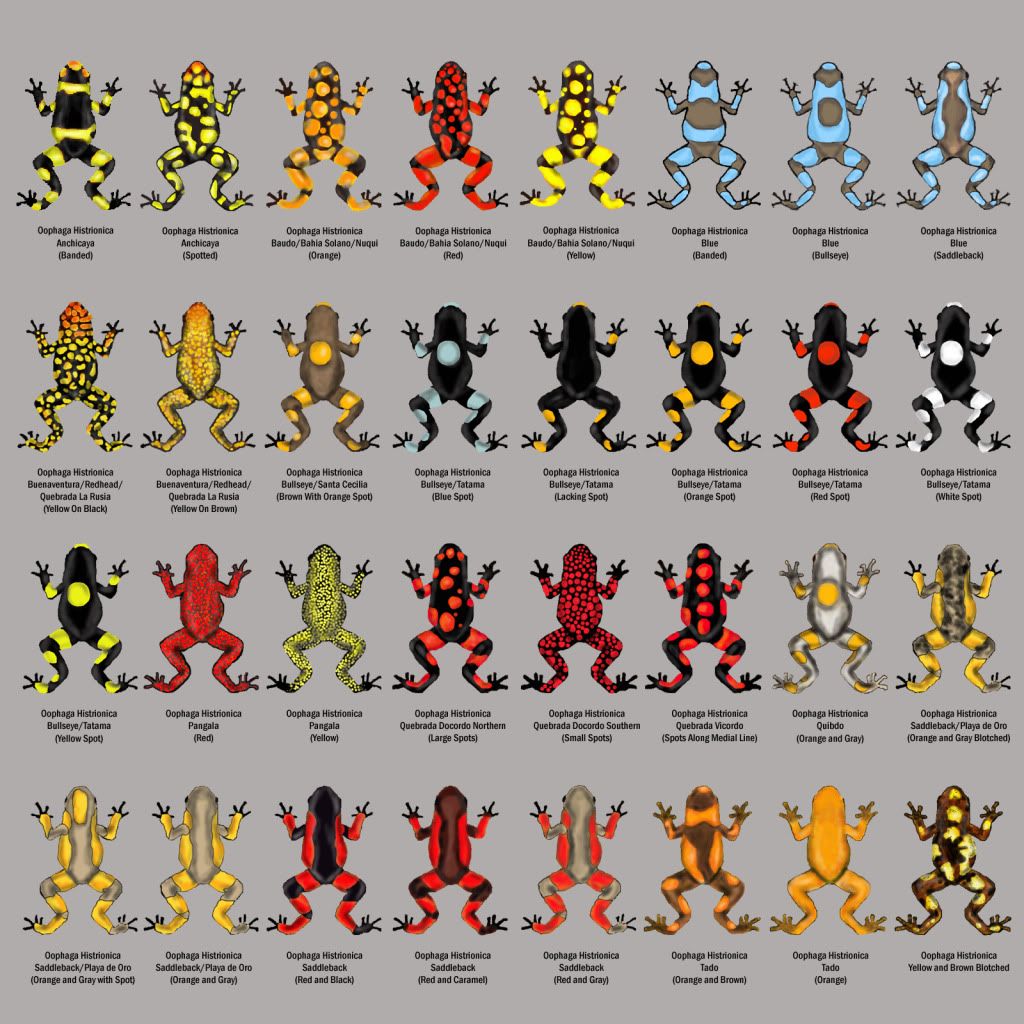[Article] 野外而非實驗室操作的例子支持捕食者能概括化多態型的獵物:以Oophaga histrionica(箭毒蛙的一種)複合群為例
圖片來源:http://www.dendrobase.hu/wp-content/uploads/2010/07/OophagaHistrionica018800_mark_aartse-tuyn.jpg
原文標題:Field but not lab paradigms support generalisation by predators of aposematic polymorphic prey: the Oophaga histrionica complex
摘要 [原文網址]
The persistence of novel aposematic forms, and thereby the evolution of aposematic polymorphism, remain intriguing. Novel and rare forms could be disproportionally attacked by predators that already learned to avoid a pre-existing and more common aposematic form. Alternatively, novel forms could be less frequently attacked if predators are reluctant to attack unknown potential prey (neophobia) or if previous learning allows them to generalise and recognise the novel form as toxic. We used colour variation in polymorphic poison frogs (Oophaga histrionica complex) to test whether predators familiar with one aposematic form do generalise their avoidance behaviour to other aposematic forms. To strengthen our inference, we combined a field test of attack rates to local and non-local models with a lab experiment of generalisation capabilities by newly born chicks. Field predators attacked a significantly lower proportion of 529 aposematic compared to 150 cryptic models. Predators co-occurring with the local aposematic form of O. histrionica equally avoided non-local forms, especially in areas where the species was abundant. Forty-two lab chicks learned to discriminate between an aposematic and a cryptic image, but failed to generalise to other aposematic images, even though we tried with six combinations of aposematic forms. To better mimic the situation in the field, we further tested whether chicks trained with a set of four simultaneous aposematic images would generalise better. They failed to learn the discrimination task. Our data contrast with previous field studies on other poison frogs, and support a role for generalisation, and arguably not neophobia, in predator avoidance of novel aposematic forms.
首先介紹這個箭毒蛙,其實我跟牠不熟,但查了以後發現他真的很多型
原文標題:Field but not lab paradigms support generalisation by predators of aposematic polymorphic prey: the Oophaga histrionica complex
摘要 [原文網址]
The persistence of novel aposematic forms, and thereby the evolution of aposematic polymorphism, remain intriguing. Novel and rare forms could be disproportionally attacked by predators that already learned to avoid a pre-existing and more common aposematic form. Alternatively, novel forms could be less frequently attacked if predators are reluctant to attack unknown potential prey (neophobia) or if previous learning allows them to generalise and recognise the novel form as toxic. We used colour variation in polymorphic poison frogs (Oophaga histrionica complex) to test whether predators familiar with one aposematic form do generalise their avoidance behaviour to other aposematic forms. To strengthen our inference, we combined a field test of attack rates to local and non-local models with a lab experiment of generalisation capabilities by newly born chicks. Field predators attacked a significantly lower proportion of 529 aposematic compared to 150 cryptic models. Predators co-occurring with the local aposematic form of O. histrionica equally avoided non-local forms, especially in areas where the species was abundant. Forty-two lab chicks learned to discriminate between an aposematic and a cryptic image, but failed to generalise to other aposematic images, even though we tried with six combinations of aposematic forms. To better mimic the situation in the field, we further tested whether chicks trained with a set of four simultaneous aposematic images would generalise better. They failed to learn the discrimination task. Our data contrast with previous field studies on other poison frogs, and support a role for generalisation, and arguably not neophobia, in predator avoidance of novel aposematic forms.
首先介紹這個箭毒蛙,其實我跟牠不熟,但查了以後發現他真的很多型
圖片來源:http://i795.photobucket.com/albums/yy235/frogandtoadarefriends/Dart%20Frogs/HISTRIONICAGUIDE.jpg
如上圖所示,如果這是真的,那麼這個箭毒蛙至少有40個型,那麼一來這是警戒色,二來捕食者會對這樣的獵物有什麼反應呢?
本文同時進行了野外與實驗室的操作,野外的實驗發現相較於隱蔽的模型而言,捕食者的確較少攻擊具有警戒色的模型,而如果把不是這個區域的型放進來測試的話,當地的捕食者也會避免攻擊這樣的獵物,也就是已經將這些型概括化,而這或許是從捕食者自身的經驗變化而來。另一部分在實驗室的實驗,測試剛出生的小雞對這些模型的反應,結果則顯示雖然小雞能夠分辨警戒色與隱蔽色的差異,但是無法將不同的型概括化。
這個文章很有趣的告訴我們幾件事
1. 野外的情況與實驗室的結果差異甚大,這代表那些用雞做實驗的文章是否需要再探討?
2. 概括化是由經驗累積而來,但出生的小雞的馴化過程是否算是有足夠的經驗累積?或是雞太笨?如果換成其他的鳥或蜥蜴會有一樣的結果嗎?
3. 如果野外的捕食者大多具有概括化能力,那麼就能解釋很多類群具有奇怪的多態型,即使捕食者不是廣域性的也行
4. 獵物本身的每個型似乎還是必須具備警戒性才行,這樣的理論才能成立。
5. 又或者其實族群同時有警戒與隱蔽,但隱蔽性的全被選汰掉了,只有具有警戒性的才能留下來?
好有趣啊,呵呵。







0 comments